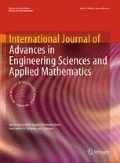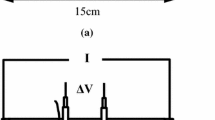Abstract
Electrical response of cementitious systems can be used to understand the evolving microstructure, and thus to provide indications of the mechanical and durability performance of such systems. This paper deals with the use of a generalized effective medium (GEM) theory to predict the porosity of cement pastes and concretes containing several cement replacement materials. Methodologies to obtain the pore solution conductivities and an equivalent soild phase conductivity in the case of concretes are outlined. The predicted porosities are found to match well with the experimental values obtained from a vacuum saturation method. It is shown in this paper that the critical exponent in the GEM equation influences the predicted porosities and a universal value for this exponent cannot be used in continuum percolating systems such as cement pastes and concretes. The thermal signature of hydrating cementitious systems, represented using the equivalent age maturity index, is related to a microstructural parameter obtained from electrical impedance. A unique relationship is observed between the equivalent age and the microstructural parameter irrespective of the mixture design parameters thereby providing a crucial link between maturity and microstructure development.










Similar content being viewed by others
References
Christensen, B.J., Coverdale, R.T., Olson, R.A., Ford, S.J., Garboczi, E.J., Jennings, H.M., Mason, T.O.: Impedance spectroscopy of hydrating cement-based materials: measurement, interpretation, and application. J. Am. Ceram. Soc. 77(11), 2789–2804 (1994)
McCarter, W.J., Starrs, G., Chrisp, T.M.: Immitance spectra for Portland cement/fly ash based binders during early hydration. Cem. Concr. Res. 30, 377–387 (1999)
McCarter, W.J., Starrs, G., Chrisp, T.M., Blewett, J.: Characterization and monitoring of cement-based systems using intrinsic electrical property measurements. Cem. Concr. Res. 30, 197–206 (2003)
Gu, P., Xie, P., Beaudoin, J.J.: Impedance characterization of micro-cracking behavior in fiber-reinforced cement composites. Cem. Concr. Compd. 15(3), 173–180 (1993)
Neithalath, N., Weiss, J., Olek, J.: Characterizing enhanced porosity concrete using electrical impedance to predict acoustic and hydraulic performance. Cem. Concr. Res. 36, 2074–2085 (2006)
Li, Z., Wei, X., Li, W.: Preliminary interpretation of portland cement hydration process using resistivity measurements. ACI Mater. J. 100(3), 253–257 (2003)
Schwarz, N., DuBois, M., Neithalath, N.: Electrical conductivity based characterization of plain and coarse glass powder modified cement pastes. Cem. Concr. Compos. 29(9), 656–666 (2007)
Whittington, H.W., McCarter, J., Forde, M.C.: The conduction of electricity through concrete. Mag. Concr. Res. 33(114), 48–60 (1981)
Neithalath, N.: Extracting the performance predictors of pervious concretes from electrical conductivity spectra. Cem. Concr. Res. 37(5), 796–804 (2007)
Manchiryal, R.K., Neithalath, N.: Analysis of the influence of material parameters on the electrical conductivity of cement pastes and concretes. Mag. Concr. Res. 61(4), 257–270 (2009)
Christensen, B.J., Mason, T.O., Jennings, H.M.: Influence of silica fume on the early hydration of Portland cements using impedance spectroscopy. J. Am. Ceram. Soc. 75(4), 939–945 (1992)
Jain, J.A., Neithalath, N.: Chloride transport in fly ash and glass powder modified concretes-Influence of test methods on microstructure. Cem. Concr. Compos. 32(2), 148–156 (2010)
Neithalath, N., Jain, J.A.: Relating rapid chloride transport parameters of concretes to microstructural features extracted from electrical impedance. Cem. Concr. Res. 40(7), 1041–1051 (2010)
ASTM C 1074: Standard Practice for Estimating Concrete Strength by the Maturity Method, 9 pp. ASTM International, West Conshohocken (2004)
Kovacik, J.: Electrical conductivity of two-phase composite material. Scr. Mater. 39(2), 153–157 (1998)
Boccaccini, A.R.: Predicting the electrical conductivity of two phase composite materials. Scr. Mater. 36(10), 1195–1200 (1997)
Sen, P.N., Scala, C., Cohen, M.H.: A self similar model for sedimentary rocks with application to the dielectric constant of fused glass beads. Geophysics 46(5), 781–795 (1981)
Bussian, A.E.: Electrical conductance in a porous medium. Geophysics 48(9), 1258–1268 (1983)
Milton, G.W.: Concerning bounds on the transport and mechanical properties of multicomponent composite materials. Appl. Phys. A 26, 125–130 (1981)
Stroud, D.: Generalized effective-medium approach to the conductivity of an inhomogeneous material. Phys. Rev. B 12, 3368–3373 (1975)
Hashin, Z., Shtrikman, S.: A variational approach to the theory of the effective magnetic permeability of multiphase materials. J. Appl. Phys. 33, 3125–3131 (1962)
McLachlan, D.S.: Measurement and analysis of a model dual-conductivity medium using a generalized effective-medium theory. J. Phys. C: Solid State Phys. 21, 1521–1532 (1988)
Merrill, W.M., Diaz, R.E., LoRe, M.M., Squires, M.C., Alexopoulos, N.G.: Effective medium theories for artificial materials composed of multiple sizes of spherical inclusions in a host continuum. IEEE Trans. Antennas Propag. 47, 142–148 (1999)
Cai, W.-Z., Tu, S.-T., Gong, J.-M.: A physically based percolation model of the effective electrical conductivity of particle filled composites. J. Compos. Mater. 40(23), 2131–2142 (2006)
McLachlan, D.S., Blaszkiewicz, M., Newnham, R.E.: Electrical resistivity of composites. J. Am. Ceram. Soc. 73(8), 2187–2203 (1990)
McLachlan, D.S., Rosenbaum, R., Albers, A., Eytan, G., Grammatica, N., Hurvits, G., Pickup, J., Zaken, E.: The temperature and volume fraction dependence of the resistivity of granular Al-Ge near the percolation threshold. J. Phys. Condens Matter 27(5), 4829 (1993)
Bentz, D.P.: Fibers, percolation, and spalling of high performance concrete. ACI Mater. J. 97(3), 351–359 (2000)
Garboczi, E.J., Bentz, D.P.: Modelling of the microstructure and transport properties of concrete. Constr. Build. Mater. 10(5), 293–300 (1996)
Carmona, F., Barreau, F., Delhaes, P., Canet, R.: An experimental model for studying the effect of anisotropy in percolative conduction. J. Phys. Lett. 41, 531–534 (1980)
Balberg, I., Binenbaum, N.: Scher and Zallen criterion: Applicability to composite systems. Phys. Rev. B 35, 8749–8752 (1987)
RILEMCPC11.3: Absorption of water by immersion under vacuum. Mater. Struct. 17, 391–394 (1984)
Snyder, K.A., Feng, X., Keen, B.D., Mason, T.O.: Estimating the electrical conductivity of cement paste pore solutions from OH−, K+ and Na+ concentrations. Cem. Concr. Res. 33, 793–798 (2003)
Schwarz, N., Neithalath, N.: Influence of a fine glass powder on cement hydration: Comparison to fly ash and modeling the degree of hydration. Cem. Concr. Res. 38, 429–436 (2008)
Neithalath, N., Persun, J., Hossain, H.: Hydration in high-performance cementitious systems containing vitreous calcium aluminosilicate or silica fume. Cem. Concr. Res. 39(6), 473–481 (2009)
Garboczi, E.J., Bentz, D.P.: Percolation aspects of cement paste and concrete: Properties and durability. High performance concrete: Research to practice. ACI Spec. Publ. 189, 147–164 (1999)
Bejaoui, S., Bary, B.: Modeling of the link between microstructure and effective diffusivity of cement pastes using a simplified composite model. Cem. Concr. Res. 37(3), 469–480 (2007)
Bentz, D.P., Garboczi, E.J.: Percolation of phases in a three-dimensional cement paste microstructure. Cem. Concr. Res. 21, 325–344 (1991)
McLachlan, D.S., Sauti, G.: The AC and DC conductivity of nanocomposites. J. Nanomater. (2007). doi:10.1155/2007/30389
Manchiryal, R.K.: Dielectric Response Based Characterization and Strength Prediction of Cementitious Materials. PhD Dissertation, Clarkson University, Potsdam, New York (2009)
Stauffer, D., Aharony, A.: Introduction to Percolation Theory, 2nd edn. Taylor & Francis, Philadelphia (1992)
Zhang, J., Li, Z.: Application of GEM equation in microstructure characterization of cement-based materials. J. Mater. Civ. Eng. 21(11), 648–656 (2009)
Wu, J., McLachlan, D.S.: Percolation exponents and thresholds obtained from the nearly ideal continuum percolation system graphite-boron nitride. Phys. Rev. B 56, 1236–1247 (1997)
Persun, J.D.: Electrical Impedance Based Strength Predictions of Concretes and Validation of a Sensing Tool for Fresh Properties. MS Thesis, Clarkson University, Potsdam, New York (2010)
Nover, G., Heikamp, S., Meurer, H.J., Freund, D.: In situ electrical conductivity and permeability of mid-crustal rocks from the KTB drilling: Consequences for high conductive layers in the earth crust. Surv. Geophys. 19, 73–85 (1998)
Bentz, D.P., Hwang, J.T.G., Hagwood, C., Garboczi, E.J., Snyder, K.A., Buenfeld, N., Scrivener, K.L.: Interfacial zone percolation in concrete: Effects of interfacial zone thickness and aggregate shape. Microstructure of cement-based systems, bonding and interfaces in cementitious materials. Mater. Res. Soc. 370, 437–442 (1995)
Winslow, D.N., Cohen, M.D., Bentz, D.P., Snyder, K.A., Garboczi, E.J.: Percolation and pore structure in mortars and concrete. Cem. Concr. Res. 24(1), 25–37 (1994)
Tank, R.C., Carino, H.J.: Rate constant functions for strength development of concrete. ACI Mater. J. 88(1), 74–83 (1991)
Acknowledgements
The authors acknowledge the financial support for the conduct of this work from the Advanced Transportation Technologies program of New York State Energy Research and Development Authority (NYSERDA) through projects 9613 and 10719. The contents of this paper reflect the views of the authors who are responsible for the facts and accuracy of the data presented herein, and do not necessarily reflect the views and policies of the funding agency, nor do the contents constitute a standard, specification, or a regulation.
Author information
Authors and Affiliations
Corresponding author
Rights and permissions
About this article
Cite this article
Neithalath, N., Persun, J. & Manchiryal, R.K. Electrical conductivity based microstructure and strength prediction of plain and modified concretes. Int J Adv Eng Sci Appl Math 2, 83–94 (2010). https://doi.org/10.1007/s12572-011-0023-1
Published:
Issue Date:
DOI: https://doi.org/10.1007/s12572-011-0023-1




